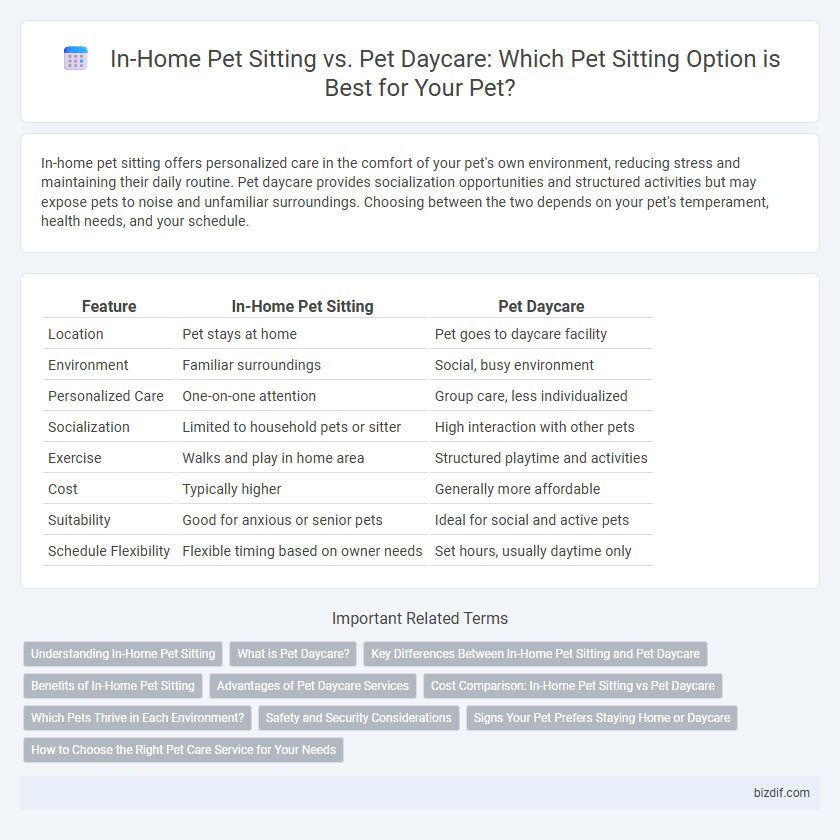In-home pet sitting offers personalized care in the comfort of your pet's own environment, reducing stress and maintaining their daily routine. Pet daycare provides socialization opportunities and structured activities but may expose pets to noise and unfamiliar surroundings. Choosing between the two depends on your pet's temperament, health needs, and your schedule.
Table of Comparison
| Feature | In-Home Pet Sitting | Pet Daycare |
|---|---|---|
| Location | Pet stays at home | Pet goes to daycare facility |
| Environment | Familiar surroundings | Social, busy environment |
| Personalized Care | One-on-one attention | Group care, less individualized |
| Socialization | Limited to household pets or sitter | High interaction with other pets |
| Exercise | Walks and play in home area | Structured playtime and activities |
| Cost | Typically higher | Generally more affordable |
| Suitability | Good for anxious or senior pets | Ideal for social and active pets |
| Schedule Flexibility | Flexible timing based on owner needs | Set hours, usually daytime only |
Understanding In-Home Pet Sitting
In-home pet sitting provides personalized care by allowing pets to remain in their familiar environment, reducing stress and anxiety often caused by new surroundings. Unlike pet daycare, which involves group settings and potential exposure to illnesses, in-home pet sitting ensures one-on-one attention and tailored routines. This option is ideal for pets with special needs, elderly animals, or those requiring medication and individualized care.
What is Pet Daycare?
Pet daycare provides a supervised, social environment where pets receive care and interaction during the day while owners are at work or away. Facilities offer structured activities, exercise, and monitoring by trained staff to support pets' physical and emotional well-being. This service differs from in-home pet sitting, which involves personalized care within the pet's familiar home surroundings.
Key Differences Between In-Home Pet Sitting and Pet Daycare
In-home pet sitting offers personalized care in the pet's familiar environment, reducing stress and maintaining routine, whereas pet daycare provides socialization opportunities and structured activities in a group setting. In-home sitters accommodate specific medical and behavioral needs with individualized attention, while daycares operate on set schedules with multiple pets under supervision. Choosing between the two depends on the pet's temperament, socialization level, and the owner's preference for convenience versus personalized care.
Benefits of In-Home Pet Sitting
In-home pet sitting provides personalized care by allowing pets to stay in their familiar environment, reducing stress and anxiety compared to pet daycare. It offers tailored attention to each pet's routine, dietary needs, and medical requirements, ensuring consistent comfort and well-being. This option minimizes exposure to potential illnesses and aggressive interactions common in group settings like pet daycare.
Advantages of Pet Daycare Services
Pet daycare services offer structured socialization opportunities that promote behavioral development and reduce loneliness in pets. These facilities provide professional supervision and a controlled environment, ensuring safety and prompt care throughout the day. Access to specialized activities and on-site amenities enhances physical exercise and mental stimulation compared to in-home pet sitting.
Cost Comparison: In-Home Pet Sitting vs Pet Daycare
In-home pet sitting typically costs more per day than pet daycare due to personalized one-on-one care and the convenience of staying in the pet's familiar environment. Pet daycare centers often offer lower daily rates but may include additional fees for extended hours or special services. Comparing costs requires considering the pet's specific needs, length of care, and potential savings from bundled or repeated bookings.
Which Pets Thrive in Each Environment?
Small dogs and senior pets often thrive in in-home pet sitting due to the personalized care and familiar surroundings, which reduce stress and maintain routine. Active, social animals like young dogs and puppies benefit from pet daycare environments that provide interactive play, socialization, and exercise opportunities. Cats typically prefer in-home pet sitting to avoid the anxiety of unfamiliar environments and other animals.
Safety and Security Considerations
In-home pet sitting provides a familiar and controlled environment, minimizing stress and exposure to potential illnesses compared to pet daycare facilities. Professional pet sitters conduct thorough safety checks and maintain consistent supervision, reducing the risk of accidents and escapes. Pet daycare centers may have higher risks of disease transmission and aggressive interactions due to group settings and varied animal behavior.
Signs Your Pet Prefers Staying Home or Daycare
Pets showing anxiety, restlessness, or reluctance to leave home often prefer in-home pet sitting, where familiar surroundings and routines reduce stress. Conversely, energetic pets who engage well with other animals and thrive in social environments demonstrate a clear preference for pet daycare. Observing behaviors such as tail wagging, playfulness, and eagerness to interact helps determine whether your pet favors the comfort of home or the stimulation of daycare settings.
How to Choose the Right Pet Care Service for Your Needs
In-home pet sitting offers personalized care in a familiar environment, reducing stress for pets with anxiety or medical needs, while pet daycare provides socialization opportunities and structured activities ideal for energetic animals. Consider your pet's temperament, health requirements, and social preferences when selecting a service to ensure tailored attention and optimal wellbeing. Evaluate factors such as caregiver credentials, safety protocols, and service flexibility to match your lifestyle and pet's unique needs effectively.
In-home pet sitting vs Pet daycare Infographic

 bizdif.com
bizdif.com